Draft 5:
- Further development of the playground
- Add detailed elements to the model
- Major: Waist twist Walk; Arm roller; Leg balance; Seating area
Draft 5:
Anodized aluminum creates cool, kid-friendly climbs. The panels on our Mobius® climbers are made of recycled, textured, anodized aluminum. This rust-free surface refracts sunlight for a comfortable climb all summer long and is virtually maintenance free. And it’s grippy, so it helps kids maneuver safely through their loopiest climbs. Panels in cool silver; steel supports in any ProShield® color.
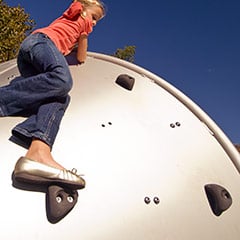
CableCore® material is tough, gentle and made to last for years. Unlike traditional ropes that can rub skin the wrong way, our CableCore material has a durable, UV-stabilized, easy-on-the-hands polyurethane coating surrounding a super-strong, aircraft-grade, galvanized-steel core. Our exclusive material won’t deteriorate or fray, become too hot in the summer or cold in the winter. And its gentle ridges provide a soft, sturdy surface kids can latch onto for climbing or hand-over-hand swinging. And with its thoughtful engineering, it can go for a generations without replacement! U.S. Patent #6,475,117

We use Glass Fiber Reinforced Concrete (GFRC) and wet-cast concrete to create specific concrete products. We spray GFRC into molds to create larger scale panels with intricate surface detail. GFRC can also be hand-sculpted onto steel frames, which we use to create more sculptural elements like 3D figures, animals and highly customized designs. We use wet-cast concrete to mold solid objects with precise detail.
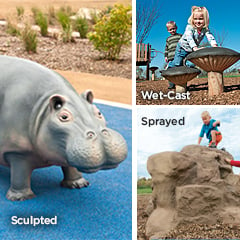
CoolToppers® are designed to protect kids from up to 90 percent of the sun’s harmful UV rays and keep playground temperatures up to 30 degrees cooler. It’s also flame retardant and resistant to mildew, fading and ultraviolet rays, making it a long-lasting, great looking addition to your playground. Available in seven colors shown, and custom colors for an additional charge.

We only use galvanized steel for maximum durability. All galvanized steel parts are ProShield® finished for optimum corrosion resistance, UV stability and gloss retention.
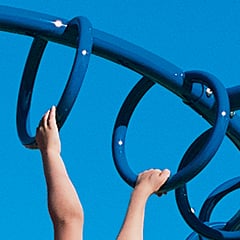
GripX is a UV stabilized HDPE (high-density polyethylene), marine-grade material. Specially designed slip resistant texture enhances traction and appearance. Easy to clean and endures harsh climate conditions.
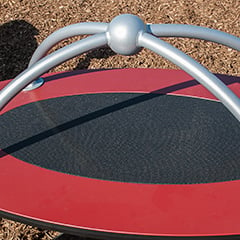
Permalene® panels look like new year after year. In 1985, Landscape Structures introduced Permalene material to the marketplace in kid-friendly activity panels. Today, we use this strong 3/4”-thick, customized material for interactive play panels, tables, handholds and signs. The distinctive black core in these 73 percent post-consumer recycled panels is the result of combining and recycling colored plastic household containers.
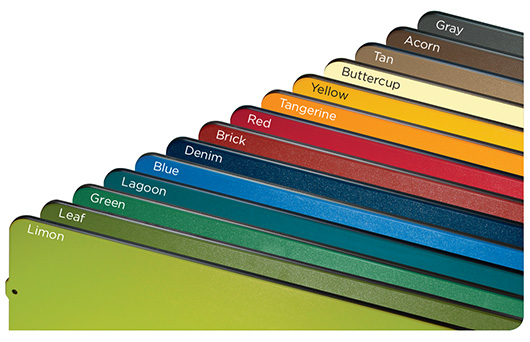
Difference you can see! ProGuard is a new super-resistant finish now applied standard to all Landscape Structures swing chain that’s at least two times more corrosion resistant than galvanized steel chain.
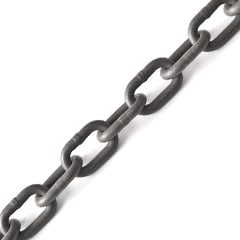
ProShield® finish is a smart combination of beauty and brawn. Our ProShield finish is so tough, it substantially increases the durability of our products. We’ve combined a specially formulated primer with a high-quality, architectural-grade powdercoat topcoat. The result is enhanced longevity, greater protection against harsh UV rays, prevention from corrosion and improved product performance. You’ll first notice the vibrant, long-lasting color and glossier finish. You’ll appreciate the fact that something so attractive also reduces corrosion and chipping, requiring less maintenance. It’s available in all the great colors you’ve come to love. And we reclaim our epoxy primer within the process, eliminating waste powder.
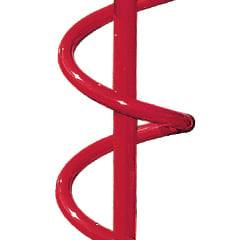
Looks like wood, but lasts longer and are easier to clean. Created from 100% post-consumer high-density UV-stabilized polyethylene material to prevent warping in direct sun. Thickness of material varies by individual product.

The heavy-duty rotationally molded polyethylene material ensures strength and durability while resisting cracking, fading and peeling. Components constructed of durable double-walled polyethylene have built-in safety and are easy to install.
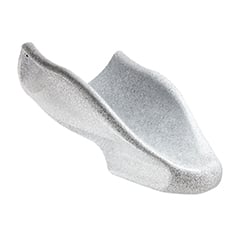
Steel-reinforced cables provide years of safe, bouncy fun. Made of tightly woven, polyester-wrapped, six-stranded galvanized-steel cable. These abrasion-resistant, color-stable cables are extremely durable and vandal resistant. Powered by Berliner Seilfabrik, one of the most experienced manufacturers of steel cables in the world, with a global reputation for top quality since 1865.

For swing chains, handholds, pipe barriers, wheels, rings, etc. Available in Red, Tan, Blue, Brown and Gray. Insulates against temperature extremes and provides a safer grip surface compared to painted metal. TenderTuff meets all safety standards and complies with Public Law No. 110-314, Consumer Product Safety Improvement Act of 2008.
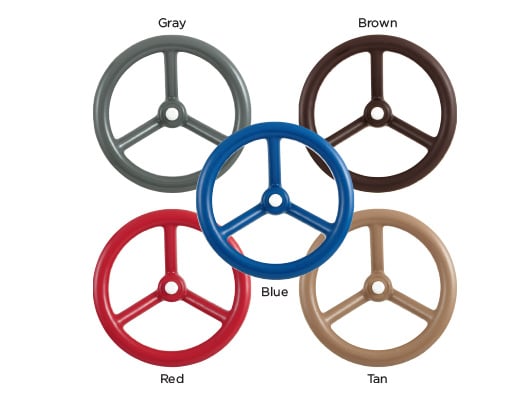
Durable, easy-to-grasp handgrips and footholds made of low-density, UV-stable polyester resin. Large enough to ensure secure grips, feels just like the climbing gym.
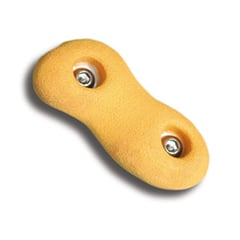
Source: https://www.playlsi.com/en/our-story/top-quality-and-service/materials-matter/materials-matter
Wet pour rubber is the EPDM (Ethylene Propylene Diene Modified) rubber granules that form the basis of wet pour playground safety surfacing. Other fixed play surfaces such as Notts Sport Childsplay are polypropylene, but some ChildsPlay systems do incorporate the use of rubber crumb.
The majority of black, wet pour playground surfaces are made from recycled car tyres. This is a positive step, as disposing of old car tyres has always been difficult and had adverse environmental impacts.
There is both a mechanical and chemical method for reclaiming the materials that the rubber granules are made from:
Different sizes of wetpour rubber are used for different applications. For instance the smallest granules (1-2 mm is this correct) are used in the Notts Sport Childsplay 90/120 system, where as medium sized granules (1-4mm) are used in the wearing course of wetpour rubber. The largest sized granules (2-8mm) are used in the base course of wet pour safety surfacing.
Initially rubber crumb was resin bound in pre-cast tiles, which were a common form of playground surfacing. Although it was easier to install, it was very susceptible to vandalism and ultimately ended up costing local authorities/parish councils too much to maintain. Hence one piece, poured wet pour was created. Look at the wet pour page for further information.
Groundwork and Leisure Services (GLS) offer a nationwide installation service for wet pour play area surfacing. Many councils are however, opting to install Notts Sport ChildsPlay system, as they offer all the benefits of wet pour with a higher level of vandalism resistance and therefore longevity. GLS therefore encourage would be clients to consider Notts Sport as potentially the best playground surface on the market.
draft 1 by Nov 2016
Draft 2 by Jan 2017
There are two theories
The 13 Postures are comprised of 8 energies and 5 steps:
8 energies are: ward off, roll back, press, push, pull, elbow strike, shoulder strike, and split
5 steps are: forward, back, look left, gaze right, and center
There are 5 different styles of Tai Chi that are connected with each other. Chen, Yang, Wu, Wu and Sun styles. All 5 styles are connected together; their outside movements are a little different but inside the energies are the same.
Chen Style – is fast and slow combined together with some jumping and stomping movements. Old form and cannon fist was created from the 17th generation.
Yang Style – Yang Luchan learned the old form/frame from the Chen family. Yang movements are slow, even, gentle, big and large. Yang Luchan learned from the 14th generation Chen family member.
Wu/Hao Style – The 1st Wu style came from Yang and Chen styles and is slow, smooth, and small and the posture is high. Wu Yuxiang learned from Yang Banhou, 2nd generation Yang family member, and then learned from Chen Qingping, 14th generation. Wu/Hao is a smaller frame.
Wu Style – 2nd Wu style comes from Quanyu who learned from Yang Banhou. They lean their body to the side but when they lean they think about being straight. Wu learned from Yang Banhou. Later in age Banhou’s frame became smaller.
Sun Style – learned from Hao Weijian. Their movements combine 3 styles of Tai Chi together, Wu, Hsing-I and Bagua.
Chen was created by Chen Wangting
Yang was created by Yang Luchan
Wu/Hao was created by Wu Yuxiang
Wu was created by Wu Jian Quan or Wu Quanyu
Sun was created by Sun Lutang
Yang Luchan learned from Chen Changxin
Wu Yuxiang learned from Yang Luchan, Yang Banhou and Chen Qingping
Wu Jianquan learned from his father, Quanyu
Sun Lutang learned from Hao Weijian
6. The most practised form now.
The Beijing 24 Form was the result of an effort by the Chinese Sports Committee, which, in 1956, brought together four Taiji teachers – Chu Guiting, Cai Longyun, Fu Zhongwen, and Zhang Yu – to create a simplified form of Taiji as exercise for the masses. The creators truncated the traditional family style Taiji forms to 24 postures; taking about six minutes to perform and to give the beginner an introduction to the essential elements of Taijiquan, yet retain the traditional flavor of traditional longer hand forms (in general, 88-108 postures). Henceforth, this form was avidly promoted by the People’s Republic of China for general exercise, and was also taught to internees in Communist “re-education” camps. Due to this official promotion, the 24-form is most likely the Taiji form with the most practitioners in China and the world over.
source:
https://en.wikipedia.org/wiki/Yang-style_t%27ai_chi_ch%27uan
https://en.wikipedia.org/wiki/24-form_tai_chi_chuan
http://www.yangfamilytaichi.com/about/study/#history-01